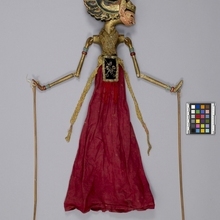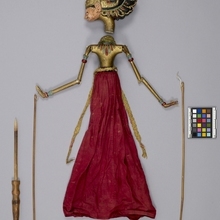Rod Puppet
MOA: University of British Columbia
Ib329 a-d
Three-dimensional male humanoid puppet: large head (part b) fits into body with skirt (part a), and a control rod (part d) with a long shaft that passes through the body and fits into the neck of the figure's head. The control rod (part c) from the figure's right arm has become detached. The body has jointed arms, each with a long controlling rod attached. Pale orange face, gold neck. Small black moustache, almond-shaped narrow eyes, narrow painted mouth. Headdress includes gelung supit urang, sumping, gold jamang, and Garuda Mungkur. Headdress black with gold, red, turquoise trim. Green and red painted necklace. Turquoise and red bracelets on upper arms and wrists. Hands at right angles to arms. Arms in two pieces attached with string at elbows and shoulders. String through palms to which sticks are attached. Wearing gold cross-over bodice, black apron with red fringe, silver and gold trim. Long gold belt hanging loose. Dark red cotton skirt. Head moves through 360 degrees.
-
Cultural Context
Theatrical performance.
-
Iconographic Meaning
Puppet features many traits indicating quality, nobility, and spirituality. Pale face, fine facial features show beauty and good nature. Elements of headdress reflect high birth. Rich clothing and ornaments further display the character's importance. These features indicate the puppet portrays the character of Satria Gondrong.
-
History Of Use
Javanese puppetry as an art form probably developed by the 11th century. The three-dimensional wooden wayang golek puppets of western Java appeared during the 16th century. Originally the plays depicted Javanese mythology, but after the Indian conquest of Java the Hindu epics, Ramayana and Mahabharata, were incorporated into the cycles, which comprise about 200 plays. An individual or group hires a dalang (puppet-master) to celebrate important occasions. The performances often last all night and are generally presented in three acts, with vocal and instrumental accompaniment. The individual plays vary widely in detail but usually involve conflict between good and evil. They serve a moral and religious purpose, and more recently, one of political commentary. Each puppet's character is represented by its appearance and placement onstage; protagonists with strong elements of good are placed to the right, antagonists of violent or evil nature to the left. Satria Gondrong is an ideal warrior; the evident hair earns him the nickname of "knight of the long hair". Known for his loyalty, faith in the code of honour, and courage, he is a popular character who appears in most sets.
- Type of Item puppet
- Culture Sundanese
- Material wood, cotton fibre, paint, fibre
- Manufacturing Technique carved, painted, sewn, tied
- Measurements height 66.8 cm, width 14.0 cm, depth 5.5 cm (part a) height 15.0 cm, width 7.0 cm, depth 15.5 cm (part b) height 34.3 cm, width 2.3 cm, depth 1.5 cm (part d)
- Previous Owner Tradewind Antiques
- Received from Museum of Anthropology Shop Volunteers, Tradewind Antiques
- Made in Java
- Ownership Date before March 15, 1983
- Acquisition Date on March 15, 1983
- Condition fair
- Current Location Case 61
- Accession Number 0886/0063 a-d

